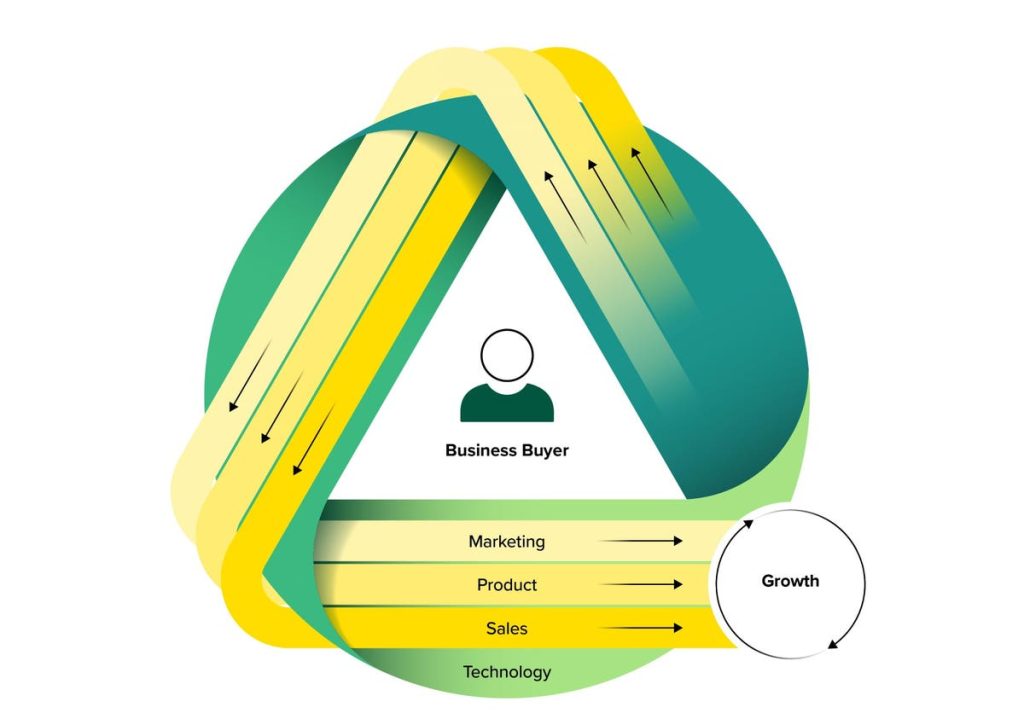As companies struggle to meet their growth expectations, they often lose focus on the fundamentals. So Forrester has released its advice to ignite sales in the form of a Growth Engine to help marketing, product and sales executives align on a better path forward. According to John Arnold, principal analyst at Forrester and a co-developer of the customer-obsessed growth engine report, “When companies are struggling, they get all these silos and focus on internal processes. They try to meet their quarterly numbers by squeezing the lemon to get more out of their buyers. But real growth looks like the fundamentals done really well.”
What are those fundamentals? Forrester’s Customer-obsessed Growth Engine identifies three critical components – create buyer value, align marketing, sales and product teams, and leverage technology. Let’s explore each of these components.
Buyer Value – “Value is in the eye of the beholder,” said Katie Fabiszak, principal analyst at Forrester and report contributor. “Most organizations are product focused and not customer centric so they lead with product messaging. They don’t do a good job of figuring out of what buyers actually care about. It’s not about delivering value, it’s about the customer recognizing and realizing value.” Forrester believes there are four dimensions of value:
- Functional – How do the features of the product or service benefit the customers? This dimensional is frequently the primary (or exclusive) focus of product development teams. And of interest to the member of the buying committee representing users of the product. But as product categories mature, there few differences between competitors on this dimension, making less distinguishing on the buying decision.
- Economic – What is the return on investment from buying this product? Salespeople are attuned to making this case to the economic buyer, often members of the procurement or finance teams. If there is perceived parity in functional benefits, this dimension becomes increasingly important.
- Experiential – How can value be received in the buying experience and the ownership experience? Because customer success teams are very focused on the ownership experience, attention has been paid to improving the customer experience. But the buying experience is often the domain of multiple teams (demand generation, website, content, business develop reps, sales, and contracts) and if not managed holistically from the buyers perspective. The focus is too often on helping sellers sell, instead of helping buyers buy.
- Symbolic – Do buyers and customers feel a sense of belonging and connectedness? Do they want to be associated with the brand? Many companies use their user communities to address this dimension for current customers and confer status to user through badges and awards. However, symbolic value is not often managed as part of the buying experience because there is little appreciation for the extended network buyers tap into when exploring, evaluating and committing to vendors.
“The most important thing about the four dimensions of value is that they are contextual,” added Fabiszak. “The ones that that are most important will be dependent on who you are talking to and where they are in the lifecycle. The finance person is probably going to lean more towards economic value. Somebody who will be a user on a day-to-day basis will likely care more about function value. I think B2C companies do a much better job of experiential and symbolic value than B2B companies because they try to get to the emotive drivers and understand consumers’ experiences. B2B firms tend to fixate on showing ROI for buyers and making sure they get usefulness out of the capabilities.”
Alignment – “There are more ways to be misaligned than aligned,” added Arnold. “B2B companies are often very sales-driven cultures, or sometimes product-driven or finance-driven cultures. Rarely do you see a marketing-driven culture. We believe that buyer centricity and customer obsession is the magic that happens for companies that are predictably growing year after year. That customer obsession piece depends on the buyer being in the center. And until very recently, sales and product didn’t have the buyer-centric mentality. That was always marketing’s job. Customer obsession is woven into the fabric of B2C; they understand their audiences a lot better. In B2B, it was always more about ‘let’s close them’. That’s kind of old school sales mentality that’s changing. Sales is becoming a lot more like marketers as they encroach on marketing. They’re sending their own emails, they have their own intent data, and they have access to all the contact information that they need to nurture leads. And they’re starting to think about the buyer experience. Because of that, it’s making them more aware of marketing. The product side of the house has always been sort of customer centric, because they build things for people, so they understand the customer and what the customer wants. But that’s been the user of the product, and not necessarily the buyer. Sales is the buyer; product is the user. So those things are converging and it’s elevating marketing in some organizations.”
“So the question always becomes, who is the aligning entity?” Arnold asked. “Is the CEO supposed to align marketing, products and sales? Is it the CFO? Or is it some level of C-suite, and that’s tops down thinking. This is more about autonomous teams that say, ‘we need to align to the buyer, let’s work together to understand the buyer wants. And then let’s create that value and make sure that it can be received’. That form of alignment is new to most organizations, because it feels very squishy. There’s not a command-and-control alignment mandate that brings it together. It’s more emotive; you have to have empathy for the buyer. And that’s traditionally a marketing function. It’s a marketing thing to have empathy for the buyer. And that’s now spreading.”
Arnold continued, “There are three different competencies that lead to this alignment – growth competencies, customer competencies, and technology competencies. Sales tends to have the most growth competency. They know how to make money and that’s what they do really, really well. Marketing tends to have the most customer competency. Product tends to have the most technology competency. You can’t leave those competencies in silos. They have to blend and share their competencies. That’s the type of alignment that we’re talking about. We’re not talking about that command-and-control or alignment to internal processes, goals and KPIs. It’s alignment to the buyer, and it is competencies coming together around the buyer.”
Technology – “B2B digital routes to market have gained in popularity to satisfy business buyers’ self-service expectations,” according to Forrester’s B2B Customer Obsessed Growth Engine report. “More than half of buyers responding to Forrester’s Buyers’ Journey Survey, 2022, reported that they used a digital transaction for their purchase. Organizations that lack a digital sales strategy may fail to meet the needs of their customers. The longer they hold off on creating such a strategy, the more likely they are to lose customers to the competition. Customer-obsessed companies make customer value central to a future fit technology strategy to deliver change at the pace of the business and the buyer.”
Which technologies should marketers be taking a close look at right now? Forrester’s CEO George Colony kicked off the conference by asserting generative AI is ready for primetime and marketers better catch up. Arnold elaborated, “You heard George this morning. There’s a lot, a lot of change. I’m working on a report right now and we’ll be talking about frontline marketer versus machine. It’s about the role of the marketer in this world of generative AI, and are the robots coming for our jobs. George mentioned the Iron Man suits and I love that analogy. And we’ll add on to that and say the buyer also comes with their own Iron Man suit. The marketer will have a role but a lot of frontline marketing jobs are going to be replaced by AI. And similarly with some sales motions, the frontline team that’s closest to the customer is going to have a whole new job, a whole new role.”
Advice for Marketing Leaders
What should marketing leaders do differently in order to activate a customer-obsessed growth engine? Arnold advocated, “CMOs really need to uplevel. In some organizations, the CMO is in a glorified demand gen role; they’re really only there for pipeline and revenue. They don’t have that more extensive CMO remit where they’re there for the marketplace, the customer and the technology strategy, forging a partnership with the technology side of the house. And partnering with sales to be there for the customer so that the arrow is pointing up to the customer. That is what CMOs are transitioning to. If you’re already one of those CMOs, then you probably need to look differently downstream. We’re writing about new strategies where frontline marketing needs to get more strategic. So if the CMO is pointing their arrow up at the customer and doing more with brand and demand interlock and they’re focused less on demand, then demand marketing, ABM, customer marketing and field marketing teams needs to have a strategy. At that level, there hasn’t always been strategy in the past. They’re always the last mile execution, everything comes top down, and they go get the leads for sales. I think CMOs need to empower those frontline teams to be more strategic, give them more autonomy, give them the number to hit, and give them the resources that they need.”
Read the full article here






